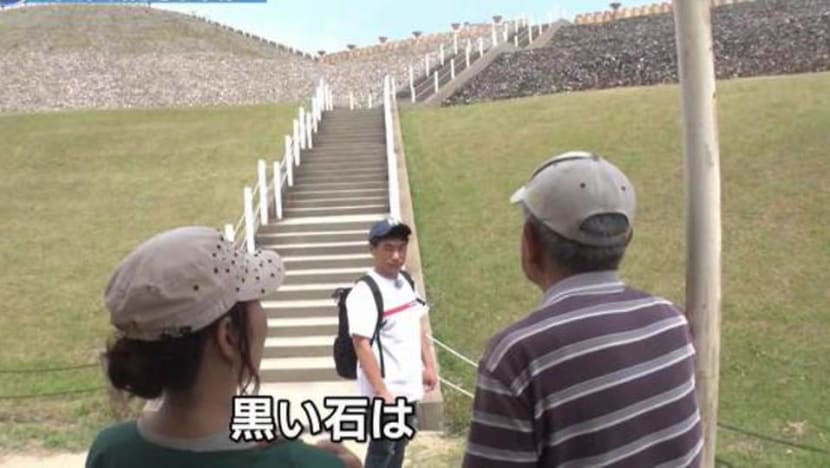Road Trip On Sanyo Railway - Part 1
Places visited this week include a park with a memorial path dedicated to famous poets and sculptors; an artificial pond which is an oasis for wild birds; and Hyogo's largest ancient keyhole tomb.

Hop onboard as we embark on a two-day journey of enquiry and discovery on the Sanyo Electric Railway Main Line in the southern part of Hyogo Prefecture. Its operator, Sanyo Electric Railway, was founded in 1907 and was initially known as the Hyogo Electric Street Car.
The line spanning 54.7km runs along the Seto Inland Sea and has a total of 43 stations, connecting Nishidai Station in Kobe City and Sanyo Himeji Station in Himeji City.
We begin by taking the 9.35am train to Sanyo Shioya Station, seven stations away from Nishidai. A passenger we speak to recommends we visit a beach called Azure Maiko, from where we can see the Akashi Kaikyo Bridge. He also tells us about an ancient tomb called Goshikizuka Kofun. Both places are located near Kasumigaoka Station.
The train reaches Sanyo Shioya Station at 9.50am. We walk towards the sea and a passerby we talk to tells us to check out the Hiraiso Greenery Park, which is built on a reclaimed beach. A popular spot here is the Nagisa no Ike pond. After walking for about 15 minutes, we arrive at the park. We notice a memorial path, which has monuments with Man'yo poems by regional artists, as well as works by famous sculptors.
We walk through the park to get to the artificial pond, which was opened to the public in April 2014. It has spot-billed ducks, egrets and common moorhens with red beaks. A variety of wild birds live around the pond.
We realise it would be easier to go to Sanyo Tarumi Station instead of Sanyo Shioya Station from the park. We are hungry by this time and a lady we meet along the way recommends we eat at Sushi Taisho. Her favourite item is the pressed mackerel sushi, which is called battera. The owner buys seafood from different ports such as Kobe and Tarumi every day. We drop by the restaurant first and order the lunch plate of the day, sushi roll with cod roe and battera marinated in vinegar.
After this, we take the train from Sanyo Tarumi to the neighbouring station of Kasumigaoka. We first walk to the recreated tomb, Goshikizuka Kofun. When it was built 1,600 years ago, there were more than 2,000 haniwa or clay sculptures, some of which were excavated from the ground and then restored to their original form. Goshikizuka Kofun is the largest keyhole-shaped tomb mound in Hyogo. We see some black stones, which were used to build the Goshikizuka Kofun, attached to the front of the tomb. They have been there for more than 1,550 years. There are also some newer white stones found at the back, which were placed 45 years ago. The top of the tomb offers a panoramic view of Akashi Kaikyo Bridge and Awaji Island.
We next go to the Azure Maiko beach, which was depicted by Hiroshige Utagawa - an Edo period ukiyo-e artist - in one of his famous pieces. The scenic spot with white sand and green pines was restored and it is now a park. There are grassy areas and a sandy beach that stretches for 800m. Akashi Kaikyo Bridge and Awaji Island can also be seen in the distance from here. At the corner of the beach is a conservation area for wild birds such as little terns, considered an endangered species in Japan. They fly here in spring and build their nests on this beach. Visitors can see them raising their babies until July.
We next take the 3pm train and advance five stops to Sanyo Akashi. We drop by a flower shop to ask about famous places. We are told to go to the Akashi City Library, from where we can see Akashi Castle. The library with glass walls is located on the fourth floor of a redeveloped building called Papios. Akashi is known as a city of books and the library opened in January 2017. At the library, there are counter seats by the windows which offer a great view of the castle. People can also read magazines and newspapers at the lounge while enjoying the view. Akashi Castle is 400 years old and its three-storey turret has been designated as a National Important Cultural Property since 1957.
We later speak to more residents and one of them mentions a shopping street called Uontana. It is known as "the kitchen of Akashi" and there are more than 100 stores selling marine products. Akashi is known for its octopus and boasts the largest catch in Japan. A lady we talk to loves the takoyaki from Takoisho, a famous Akashiyaki restaurant. Usually, Akashiyaki is served with soup for dipping, but at this store, it is soaked in a special soup to make it softer and fluffy. The soup soaks into the Akashiyaki, giving it a richer flavour. The lunch set, which costs 750 yen, also comes with octopus rice.
We now start looking for accommodation. There are not many hotels here, with none near the beach. We are advised to go to JR Nishi Akashi Station and stay at the Castle Hotel nearby. We want to take a bus to Nishi Akashi but find out it is quite far. So we decide to travel by train to Fujie Station and take a bus from there to the hotel. At Fujie, we look for a bus to JR Nishi Akashi Station. It is 5.50pm by now and the next bus is only at 6.50pm. The bus ride will take 15 minutes. If we were to walk, it will take one hour and we may not have a place to stay. We thus make the decision to walk along the bus route and try to hitchhike instead.
Tips:
1) Azure Maiko is an ideal spot for people who enjoy taking photos of wild birds
2) A must-try item in Akashi is takoyaki, also known as Akashiyaki










